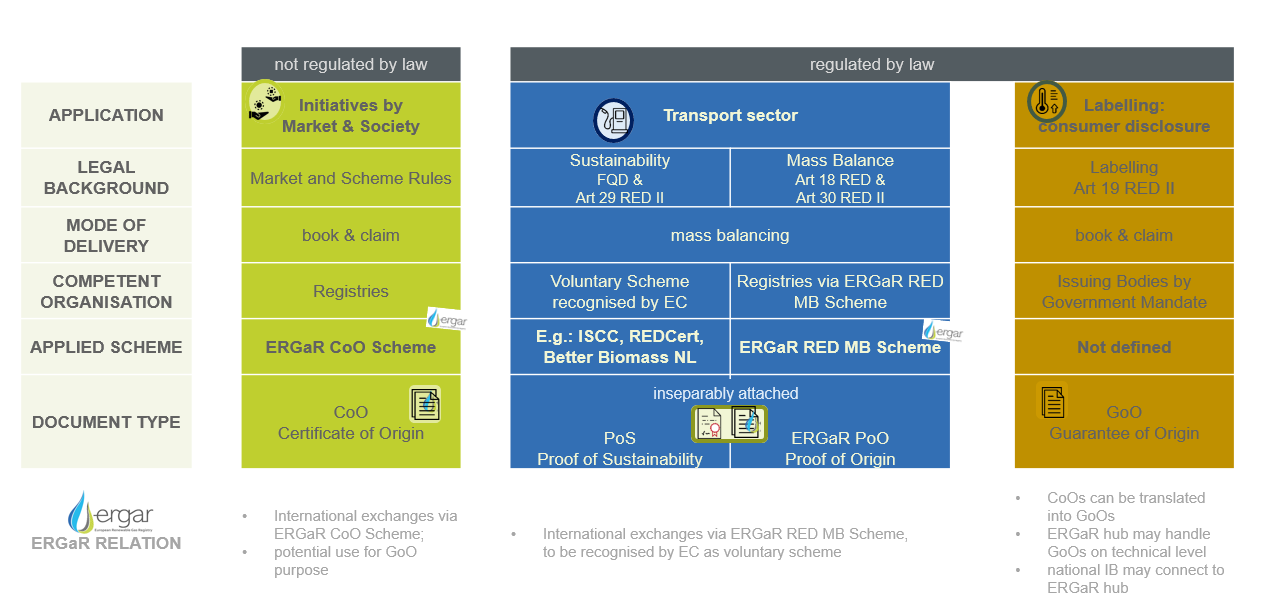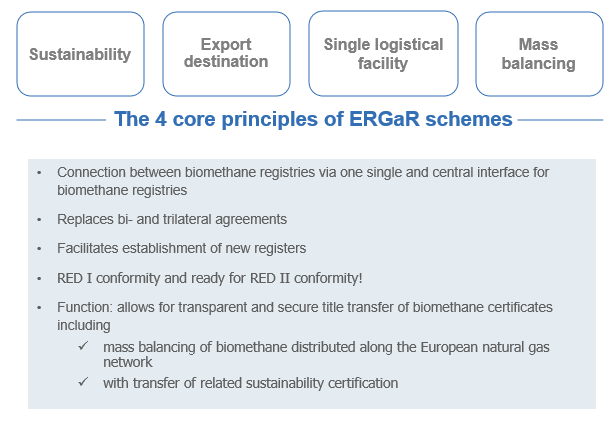ERGaR is based on the cooperation of the national renewable gas registries. ERGaR will support the establishment of national registries in every European country and will endeavour to incorporate all national registries into its scheme. The procedures of ERGaR are agreed, applying the knowledge and the experience of operating national registries through harmonisation and cooperation.
ERGaR Schemes
A renewable gas certificate is an electronic document that records (quantitative and qualitative) information about a renewable gas consignment, injected into the natural gas network. A Certificate may be used by a renewable gas producer to market the green value of their related renewable gas consignment. A Certificate may be used by a gas consumer to demonstrate their use of a renewable gas consignment, in that this consignment described in the Certificate can be set against an amount of gas that the consumer has withdrawn from the natural gas network. Certificates follow the approach detailed in Article 15 of Directive 2009/28/EC on the promotion of the use of energy from renewable sources, including amendments as per Directive (EU) 2015/1513 (also referred to as “RED I”) and Article 19 of Directive 2018/2001 of the European Parliament and of the Council of 11 December 2018 on the promotion of the use of energy from renewable sources (recast) – also referred to as “RED II”, (source: REGATRACE, 2020).


ERGaR Tracks the Chain of Custody of Renewable Gas
Within the ERGaR RED MB scheme, mass balancing is the methodology applied to trace virtually the chain of custody of renewable gas distributed along the gas network of Europe. The operation of a mass balance system enables monetising the intrinsic, green value of exported renewable gas without explicitly tracking the physical cross-border gas flow.
Purpose and Need for European Certificate Systems
Biomethane is considered a flexible energy carrier, which may be applied for a broad set of application purposes. The production and injection of renewable electricity from biomethane is a commonly known application purpose, which is subsidies in a number of European countries. The application of sustainably produced biomethane in the transportation sector as sustainable biofuel is currently gaining more relevance. However, there will be further application purposes which will raise in importance in the future, such as the application of biomethane for the EU ETS sector.
- Article 19 of the RED II which extends the system of Guarantees of Origin (GO) for consumer disclosure to cover renewable gases.
- The Articles 25-30 of the RED II which extend sustainability criteria for renewable energy use in several sectors (transport sector, heating sector, etc) in combination with target compliance.
- The Fuel Quality Directive which refers to sustainable biofuels for the transportation sector, setting specific national and European quotas.
- Consumption of renewable gases for marketing purposes e.g. in chemistry and other applications.
- Self-commitment of consumers and industry to use a certain share of energy from renewable resources or to reduce greenhouse gas emissions.
The definition of the origin, quality and quantity of renewable gases had not been requested by European legislation before the recast of the Renewable Energy Directive (RED II, 2018/2001/EU) in detail, which extends the purpose of GOs for consumer disclosure for gas including hydrogen and heating/cooling. According to Article 19 of RED II, only certificates issued under the supervision of governments or of government designated bodies can be called GOs.
European legislation encourages Member States to facilitate the Europe-wide cross-border exchange of renewable gas consignments. In order to track the movement of renewable gases in a secure, trustworthy and transparent manner, the market requires a European system for cross-border transfer and exchange of renewable gas Certificates now and expects the stakeholders, among them ERGaR European Renewable Gas Registry aisbl, to provide solutions as soon as possible. Such different application paths require specific characteristics from biomethane as a renewable gas product/commodity which have to be reflected on the information provided by the respective biomethane/renewable gas certificate.
(source: REGATRACE D2.3, 2020)
